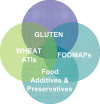Non-celiac gluten sensitivity: questions still to be answered despite increasing awareness
- PMID: 23934026
- PMCID: PMC4003198
- DOI: 10.1038/cmi.2013.28
Non-celiac gluten sensitivity: questions still to be answered despite increasing awareness
Abstract
Recently, the increasing number of patients worldwide who are sensitive to dietary gluten without evidence of celiac disease or wheat allergy has contributed to the identification of a new gluten-related syndrome defined as non-celiac gluten sensitivity. Our knowledge regarding this syndrome is still lacking, and many aspects of this syndrome remain unknown. Its pathogenesis is heterogeneous, with a recognized pivotal role for innate immunity; many other factors also contribute, including low-grade intestinal inflammation, increased intestinal barrier function and changes in the intestinal microbiota. Gluten and other wheat proteins, such as amylase trypsin inhibitors, are the primary triggers of this syndrome, but it has also been hypothesized that a diet rich in fermentable monosaccharides and polyols may elicit its functional gastrointestinal symptoms. The epidemiology of this condition is far from established; its prevalence in the general population is highly variable, ranging from 0.63% to 6%. From a clinical point of view, non-celiac gluten sensitivity is characterized by a wide array of gastrointestinal and extraintestinal symptoms that occur shortly after the ingestion of gluten and improve or disappear when gluten is withdrawn from the diet. These symptoms recur when gluten is reintroduced. Because diagnostic biomarkers have not yet been identified, a double-blind placebo-controlled gluten challenge is currently the diagnostic method with the highest accuracy. Future research is needed to generate more knowledge regarding non-celiac gluten sensitivity, a condition that has global acceptance but has only a few certainties and many unresolved issues.
Figures


References
-
- Volta U, de Giorgio R. New understanding of gluten sensitivity. Nat Rev Gastroenterol Hepatol. 2012;9:295–299. - PubMed
-
- Gibert A, Espadaler M, Angel Canela M, Sánchez A, Vaqué C, Rafecas M. Consumption of gluten-free products: should be the threshold value for traces amounts of gluten be at 20, 100 or 200 p.p.m. Eur J Gastroenterol Hepatol. 2006;18:1187–1195. - PubMed
-
- Belderok B. Developments in bread-making processes. Plant Food Hum Nutr. 2000;55:1–86. - PubMed
-
- Gobbetti M, Rizzello CG, Di Cagno R, de Angelis M. Sordough lactobacilli and coeliac disease. Food Microbiol. 2007;24:187–196. - PubMed
Publication types
MeSH terms
Substances
LinkOut - more resources
Full Text Sources
Other Literature Sources
Medical

